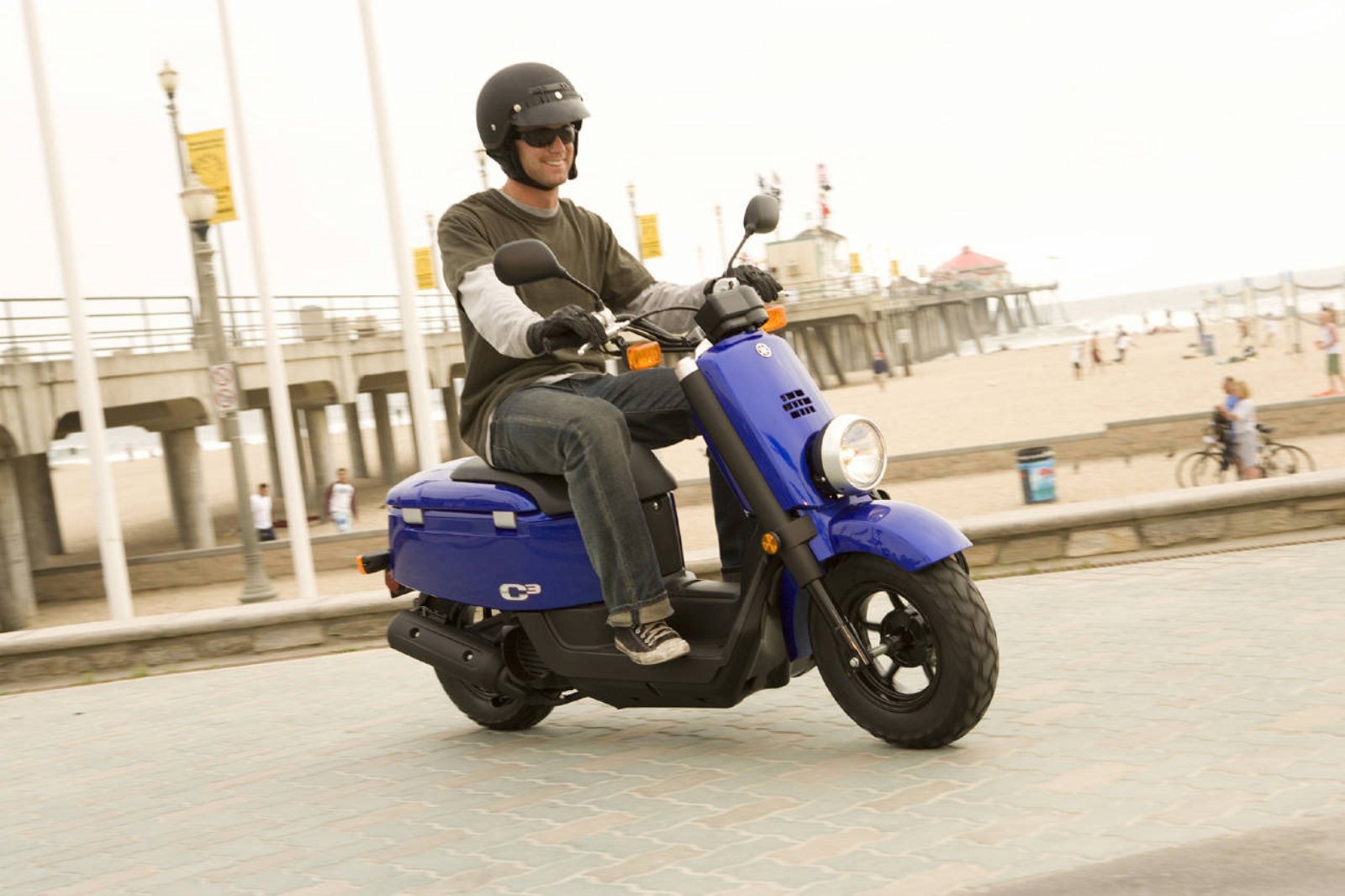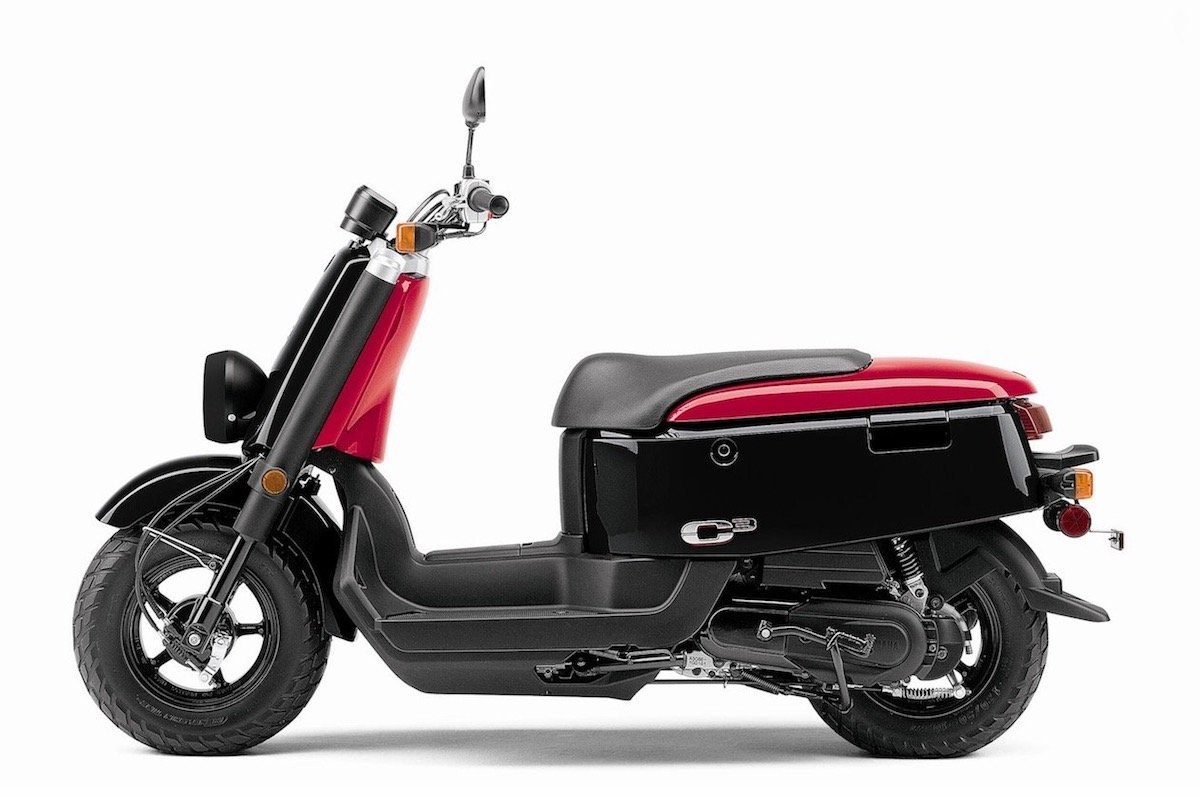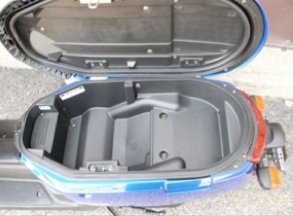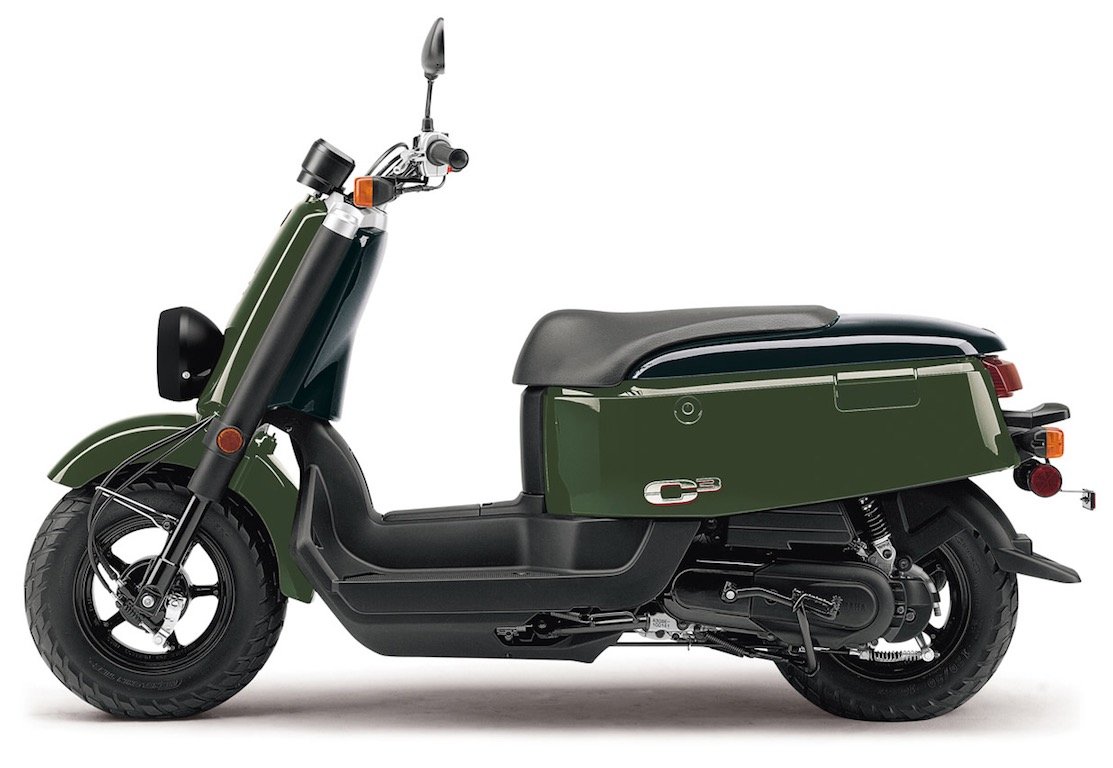YAMAHA C3 / C-CUBED (XF50)
Yamaha announced the C3 (pronounced C cubed) as part of their 2007 line up in the USA and Canada. The C3 was only the North American name for Yamaha’s XF50 scooter, which was also sold as the ‘Vox’ in Japan and the ‘Giggle’ in many European countries.
When it was introduced, the C3 was the third 50cc scooter in Yamaha’s already strong lineup (Vino 50 and Zuma). While not as popular as the other Yamaha’s, the C3 sold well enough to last for 5 years in the USA (2007 – 2011). In Canada this model was dropped after 2010, but not before offering some great colour options like the military inspired ‘Dark Greenish Gray’ and the two tone Black/Red option. For 2012 the C3 didn’t make the USA lineup, but its high tech 50cc engine did live on in the Vino 50 and the third generation (2012) Zuma 50F.
Motor
This great little engine is perhaps the most impressive thing about the C3. Yamaha raised the bar for 50cc engine technology in 2006 when they slipped a new fuel injected, liquid cooled and 3-valve engine into their formerly 2-stroke Vino. It’s this same great engine that Yamaha used in the new for 2007 C3 and later in the 2012 Zuma 50F. This engine was not only technologically ahead of anything else to date, it’s also more powerful and fuel efficient than Honda’s current 50cc engine (the GET2 used in the Ruckus & Metropolitan). Compared to the 50cc 4-stroke Honda’s, the C3 is faster accelerating with a similar or slightly higher top speed around 41-43mph (64-70km/hr). The C3’s top speed is slightly restricted by a washer that limits the top end gearing of the variator. Removing this adds a few mph but it also decreases up hill performance due to the taller gearing.
The fuel milage for this engine is amazing, but don’t set your fuel budget based on the figures posted on Yamaha’s Canadian website. Yamaha reports a fuel milage of 138mpg but that’s assuming you travel at a constant speed of 25mph (40km/hr). Ask anyone who’s ever driven a 50cc 4-stroke and they’ll tell you that this is unrealistic. 50cc 4-stroke are driven wide open 95% of the time so real world fuel milage for the C3 is normally in the (still extremely impressive) 100-110mpg range.
 Design and Amenities
Design and Amenities
Other than the neat engine, Yamaha has also given the C3 huge storage under the seat which comes in very handy for many items. Laptop computers often fit well in this space, but unfortunately it’s not deep enough to swallow a helmet. Considering that huge storage capacity seems to be the main focus of this scooter, some people might be surprised by this.
The C3 also has a fuel gauge which you don’t find on every 50cc scooter. This gauges measures the up to 1.2 gallons you’ve got in the C3’s floorboard located tank. The floorboard location is key in the C3, because it frees up the entire underseat area for storage. Most non-fuel-injected scooters hold their gasoline under the seat which allows gravity instead of a fuel pump to deliver the fuel. The C3 uses a more expensive fuel pump which frees up much appreciate space. A recall does exist for 2007 models pertaining to the fuel pump. The fuel pump commonly causes starting/running difficulties and it poses a fire danger, so have Yamaha replace this.
Other nice design touches include the inclusion of kickstand (and centerstand), the inverted front forks and the classy five spoke rims. On the downside, Yamaha had to pinch pennies somewhere so they opted to use a cheaper drum brake up front instead of a disc like they use on the Vino 50 and Zuma. Perhaps Yamaha used up too much of the budget with the high tech engine.
Discussion
What’s not to like about the C3? I’m trying to tip toe around this one, but I think it’s fair to say that the styling isn’t for everyone. I suspect even Yamaha knows this (they call it the Giggle in Europe). A lot of the design elements are nice (i.e. floorboard, rims, exhaust, gauges) but the front end is a bit cartoon-ish.
Overall, if you like the styling, this is one awesome scooter for you thanks to its ample storage and outstanding motor. If you don’t, you could utilize the XF50’s decent aftermarket parts industry to overhaul the look or you could look at the mechanically similar and retro styled Vino. If storage is your primary consideration, the Honda Elite 110 had perhaps the largest underseat storage area of any small scooter, with two helmets fitting inside. Other nice 50cc options from the C3’s era include the Honda Ruckus, Yamaha Zuma, Vespa’s LX/S 50 and Kymco’s Like 50.
Pros:
- Awesome engine
- Mileage
- Storage
Cons:
- Styling
- Drum brakes
- Shallow underseat storage doesn’t hold a full face helmet
Links:
C3 Service Manual – Very helpful manual for working on your C3. Requires registration.
MotorscooterGuide Forums – Visit the forum on this site to chat about this scoot.
JustGottaScoot – Nice review of the C3
C3 Review – Motorcycle.com review
Key Specs:
- Model Code: XF50
- Engine: 4-stroke, liquid cooled, 3-valve, fuel injected, SOHC, single
- Power: 3.8 HP
- Displacement: 49cc
- Bore and Stroke: 38mm x 43.5mm
- Compression Ratio: 12:1
- Fuel System: Mikuni 19mm Fuel Injection
- Ignition: CDI
- Transmission: Automatic (CVT)
- Front/Rear Suspension: Telescopic Fork / Single Shock
- Front / Rear Brakes: Drum / Drum
- Tires: 120/90-10 (front and rear)
- Wheelbase: 1280mm
- Seat Height: 735mm / 29”
- Dry weight: 85kg / 187lbs
- Fuel Tank: 4.5 litres
Colors:
- 2007: Deep Purplish Blue Metallic, Liquid Silver
- 2008: Vivid Red Metallic, Greenish White Metallic, Deep Purplish Blue Metallic
- 2009: Liquid Silver, Heat Red
- 2010: Raven/Red, Dark Greenish Gray (Canada Only)
- 2011: Pearl White (USA Only)



 Design and Amenities
Design and Amenities
